
"Land of Devils and Quolls"
Lecture by Dennis Moore - Article by Thomas Wilson
Tasmania may be on the other side of the Earth but biology teacher Dennis Moore brought this Island State of Australia into the mist of the Judson ecology class in a talk he gave last week. Dennis’s interesting presentation about this ancient land of temperate rain forests, alpine moorlands deep gorges, glaciers, wild coastline and remnants of prehistoric Gonwanaland flora was presented with a delightful “downunder” accent.
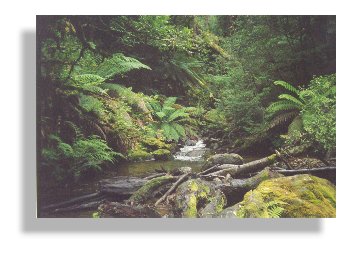
Dennis was born in Marion, Alabama, and he majored in biology at Livingston University. While in the navy, he visited Tasmania and decided to spend his life in this exotic land. He has lived in the land of the Tasmanian Devil for over 30 years and teaches at The Friends School in Hobart. Dennis usually visits me at Judson when he makes his annual trips to see his mother in Marion.
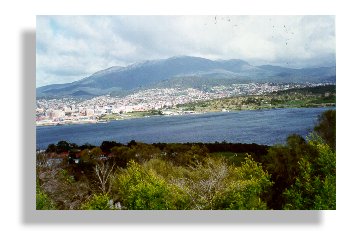
Dennis brought photographs, pamphlets, posters and maps of Tasmania that he used to illustrate his lecture on the natural history of his adopted homeland. Ruth Kastenmayer, Judson Webmaster, used the classroom computer station and projected Internet images of Tasmania on the large screen to accompany Dennis’s talk. It was an interesting and creative event for the Judson students, especially when Dennis talked about the Tasmanian Devil and Ruth placed the Devil’s image on the screen and activated a Java script voice recording and we heard the strange and somewhat frightening sounds made by this fearsome furry marsupial.
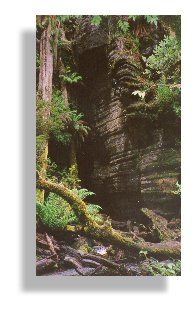
"The worst criminals of the British Isles were shipped to Tasmania in the early 1800's. Criminals were made slaves of the government and were used to build the island into a prosperous haven for future colonists. The aboriginal peoples were exterminated from the island by the mid- 1800's . White man’s diseases killed most of the native inhabitants but others were killed or transported to nearby islands. These were dynamic statements made by Dennis as he recited the early history of the island.
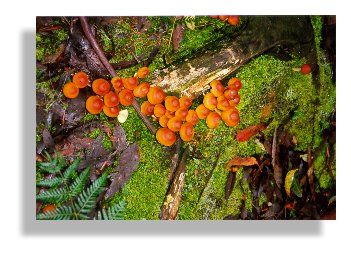
Dennis told of the beauty of the island but his story was mixed with the usual sad accounts of habitat destruction as Europeans claimed the land and its riches. Rivers were damned, old growth forests cut, and bounties were put on the head of many indigenous predators such as the Tasmanian Tiger which is now extinct.

We were amazed at the diversity of the island. Dennis told about many interesting animals such as the wedge-tailed eagle, the great numbers of marsupials, the marvelous monotremes such as the platypus and the spiny anteater, the common and highly poisonous tiger snakes, and the catlike carnivorous quolls that prowl the forest floor in search of mouse-sized little pygmy-possums.
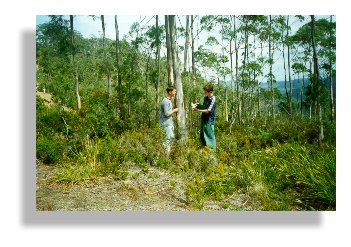
|
Dennis gave the following account of the fate of the “mutton birds” of Tasmania. “Short- tailed shearwater chicks are feed immense portions of fish for the first few weeks after hatching. The chicks get huge with fat and then the adult birds migrate back to Britain, leaving the chicks to develop solely on the stored fat held in their crop. Local islanders often collect the chicks from the burrows, kill the fat birds, and squeeze the oil and fat from their crops into containers. They sell the oil and cook the chicks. It is reported that the cooked chicks taste like mutton but I found them to be rank ... absolutely rank.”
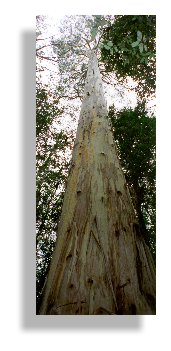
We then learned about the grand Western Tasmanian Wilderness National Parks which is listed as a World Heritage Area. This area of Tasmania was once joined in the ancient continent of Gondawanaland to the southern tip of New Zealand and to the Western Patagonia in South America. Much of these areas still resemble the ancient continent of over 200 million years ago. Fossils an existing flora are similar in all three regions. Visions of the wild rivers and temperate rainforests put the students on the edge of their seats as Dennis continued his stories of the strange and beautiful island.
“The most famous tree of Tasmania is the Huon Pine. This slow growing giant tree with exceptionally dense wood was used to make ships in the early days. Huon Pine wood lasts for centuries in the hull of ships and whaler boats. Huon pines can live over 2,000 years, grow only centimeters per year, and the wood has a rich, golden tan color.
We almost lost all the old growth Huon Pines to the lumber industry but a pure stand of the old trees is protected along the Denison River,” Dennis made these comments with obvious feeling of love and mystique for the old trees.
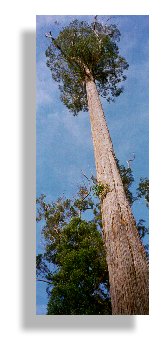
The students enjoyed learning about Tasmania and they were entertained by the quiet charm of a fine man from Marion who has been transformed into a proud part of the island established by the Dutchman, Abel Tasman, in 1642.
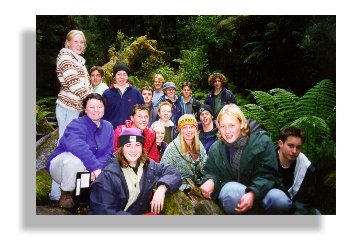
|
We invited Dennis to accompany us on a canoe trip down the Cahaba River. Dennis was excited about this invitation. Although he grew up in Marion, he had never canoed the Cahaba.
Dr. Randall Haddock and Christine Rodrick of the Cahaba River Society pulled the trailer of canoes to the Sprott Bridge on State Highway 14 and we were off for a day on the last undammed river in the State. The river was beautiful and Dennis was amazed at the diversity of the environment. We studies river mussels, seined fish, observed hundreds of butterflies on willow-leaf weeds, saw a small alligator, observed soapstone cliffs covered with velvet-like mosses and ferns and with water seeping down in trickles.
We played in the cool water currents and nimble students climbed a monster of a leaning bald cypress tree and leaped feet-first into the river. We made the best of our weather-window and escaped the river ahead of a cold northern rain.
Dennis left Tasmania in the middle of the winter and we had him on the river in a major heat alert. “My back does hurt a little,” was his only remark about the work of the trip as beads of sweat dripped from his brow. Our group truly enjoyed the river, getting to know Dennis, and learning about Tasmania. We are now starting a fund raiser ...“ Judson to Tasmania,” it only costs $2,000 air fair but this includes a stopover in Hawaii.